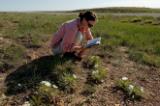Clarifying the Terminology
Over the past ten to twenty years, the concept of conserving landscape connectivity has gained recognition as a key strategy to protect biodiversity, maintain viable ecosystems and wildlife populations, and promote climate change adaptation for wildlife species. Habitat corridors are the primary tool used to achieve connectivity.
However, confusion about how best to implement connectivity and employ habitat corridors on the ground stems in part from a generalized lack of clarity about what we mean when we talk about protecting “corridors” and “landscape connectivity.” We conducted a literature review to gain a better understanding of the terminology pertinent to landscape connectivity. By attempting to synthesize the various uses of each term, we hope to add clarity to connectivity conversations.
Landscape Connectivity
"Connectivity" can be broken down into "structural connectivity" and "functional connectivity." Structural connectivity refers to the physical relationship between landscape elements whereas functional connectivity describes the degree to which landscapes actually facilitate or impede the movement of organisms between areas of habitat.
Functional connectivity is a function of both landscape structure and the behavioral response of organisms to this structure. Thus, functional connectivity is both species- and landscape-specific. Distinguishing between these two types of connectivity is important because structural connectivity does not imply functional connectivity. In general, when we use the term "connectivity" we are using the functional definition.
Habitat Corridor
Early definitions of habitat corridors approached the concept from a very literal perspective describing them as "linear" or "narrow" strips of land. But central to the rationale behind corridors is the capacity to facilitate movement, which occurs in different patterns and processes, and at different scales depending on the species of interest. Thus, habitat corridors need not be linear or narrow and must be defined from the perspective of the organism or process being targeted for conservation.
More recent definitions reflect a broadened understanding of habitat corridors, which are now described as components of the landscape that facilitate the movement of organisms between areas of intact habitat. Implicit in this definition is the idea that corridors are functional as well as structural elements of the landscape and that they are species-specific.
Linkage
Although the term is frequently used synonymously with corridor, "linkage" technically refers to broader regions of connectivity important to facilitate the movement of multiple species and maintain ecological processes.
Matrix
Throughout the literature reviewed here, definitions of the "matrix" were generally vague. Most commonly, the matrix is defined as "non-habitat" and/or the portion of the landscape in which habitat patches and corridors are "embedded." This very black and white interpretation fails to capture the myriad land cover types and functional continuum that constitute the matrix. Precisely, the matrix is any land cover type other than the type of interest. In other words, the matrix may be anything from urban development to agricultural land to grassland or forest. Matrix lands have the potential to function as habitat – though always as less preferred habitat – as well as the capacity to be barriers to movement. Just as with connectivity, the role played by the matrix will depend both on its composition and on the unique behavioral response of the species under consideration.
Landscape Permeability
In contrast to landscape connectivity – which characterizes the capacity of individual species to move between areas of habitat via corridors and linkage zones – permeability refers to the degree to which whole landscapes, encompassing a variety of natural, semi-natural and developed land cover types, are compatible with wildlife needs and sustain ecological processes. Multi-scale, multi-stakeholder, sustainable land management strategies that not only target conservation areas like reserves and corridors, but also target the matrix, including areas of human development, are essential to achieving landscape permeability.
Scale
In the context of connectivity, scale refers to the spatial and/or temporal dimension in which the conservation target (i.e. species or process) operates. Since species vary widely in the distances and timeframes in which they travel, identifying the operative scale(s) of the focal species or process is critical to designing successful connectivity management programs.
Ecological Network
The ecological network concept embodies several key elements: connectivity at the landscape scale, which is achieved through conservation areas and corridors; permeability at the landscape scale, which is achieved through buffer zones and sustainable use of the matrix; and incorporation of human cultural and/or socioeconomic factors with wildlife needs. Thus, we feel Bennett (2004) aptly defined ecological networks as coherent systems of natural or semi-natural landscape elements configured and managed with the objective of maintaining or restoring ecological functions as a means of conserving biodiversity while also providing appropriate opportunities for the sustainable use of natural resources.
Go Straight to Your State
Learn about conservation and open space in your state.


